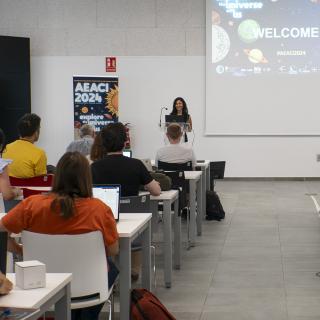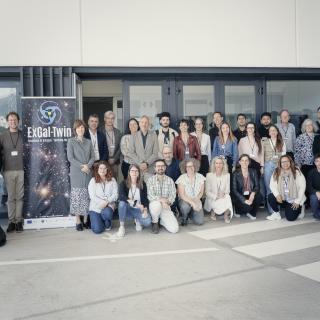Las primeras Jornadas de Puertas Abiertas en el Observatorio del Roque de los Muchachos (La Palma) correspondientes al año 2001, celebradas el pasado domingo, 15 de julio, y organizadas por el Instituto de Astrofísica de Canarias, atrajeron al Observatorio a 2.272 visitantes. Durante la jornada se pudieron visitar seis instalaciones distintas: el telescopio "William Herschel", el telescopio "Isaac Newton", el telescopio Nacional Galileo, el telescopio Nórdico Óptico, el telescopio "Mercator" y el experimento HEGRA. La organización contó con la colaboración de 48 personas, entre astrónomos de las distintas instituciones usuarias del Observatorio, personal propio de apoyo (administrativo, sanitario y de mantenimiento), además de diversas entidades como la agrupación de astrónomos aficionados "Isla de la Palma", AEA, Guardia Civil y Cruz Roja. Las visitas se realizaron en tres idiomas: español, inglés y alemán, y los 2.272 visitantes fueron divididos en 84 grupos distintos, cifras que superan considerablemente las de las jornadas celebradas el pasado año. La novedad en esta ocasión fue la posibilidad de visitar el telescopio "Mercator", el "benjamín" del Observatorio, que entró en funcionamiento el pasado mes de mayo. Se recuerda que las próximas Jornadas de Puertas Abiertas tendrán lugar el domingo 9 de septiembre.
Advertised on
It may interest you
-
 Yesterday saw the start of the 10th International School Astronomy Education Adventure in the Canary Islands (AEACI 2024) which will be celebrated during the full week in the IACTEC building in La Laguna (Tenerife), and which 65 teachers from 23 countries are attending. This school, organized by the Instituto de Astrofísica de Canarias (IAC) together with other scientific and educational institutions, has reached its tenth anniversary, and has given training in the teaching of astronomy to 600 teachers from all over the world. With the title “Explore the Universe with us” the AEACI 2024 hasAdvertised on
Yesterday saw the start of the 10th International School Astronomy Education Adventure in the Canary Islands (AEACI 2024) which will be celebrated during the full week in the IACTEC building in La Laguna (Tenerife), and which 65 teachers from 23 countries are attending. This school, organized by the Instituto de Astrofísica de Canarias (IAC) together with other scientific and educational institutions, has reached its tenth anniversary, and has given training in the teaching of astronomy to 600 teachers from all over the world. With the title “Explore the Universe with us” the AEACI 2024 hasAdvertised on -
 The Canary Islands Institute of Astrophysics (IAC) is promoting knowledge about European project management with a dedicated forum taking place on April 23 and 24 at the IACTEC headquarters in Tenerife. The 2025 ExGal-Twin Regional Workshop on European Project Management is an event organized by the ExGal-Twin project and the Office of Transfer and Institutional Actions (OTAI) of the Instituto de Astrofísica de Canarias (IAC), under the title "Innovation in European Project Management: Challenges and Opportunities" . The main objective of this workshop is to bring together R&D&I entitiesAdvertised on
The Canary Islands Institute of Astrophysics (IAC) is promoting knowledge about European project management with a dedicated forum taking place on April 23 and 24 at the IACTEC headquarters in Tenerife. The 2025 ExGal-Twin Regional Workshop on European Project Management is an event organized by the ExGal-Twin project and the Office of Transfer and Institutional Actions (OTAI) of the Instituto de Astrofísica de Canarias (IAC), under the title "Innovation in European Project Management: Challenges and Opportunities" . The main objective of this workshop is to bring together R&D&I entitiesAdvertised on -
 El programa Investigadores Visitantes Fundación Occident del Instituto de Astrofísica de Canarias (IAC) sigue su curso con la recepción de un nuevo grupo de personal investigador procedente de distintos centros del mundo. Los investigadores cubrirán un amplio espectro de disciplinas, desde cosmología y astrofísica de partículas hasta física estelar, formación de galaxias y sistemas planetarios. Su presencia y colaboración con el personal investigador del IAC fortalecerá la actividad científica tanto del centro canario como de las personas invitadas y de sus centros de origen, fortaleciendoAdvertised on
El programa Investigadores Visitantes Fundación Occident del Instituto de Astrofísica de Canarias (IAC) sigue su curso con la recepción de un nuevo grupo de personal investigador procedente de distintos centros del mundo. Los investigadores cubrirán un amplio espectro de disciplinas, desde cosmología y astrofísica de partículas hasta física estelar, formación de galaxias y sistemas planetarios. Su presencia y colaboración con el personal investigador del IAC fortalecerá la actividad científica tanto del centro canario como de las personas invitadas y de sus centros de origen, fortaleciendoAdvertised on